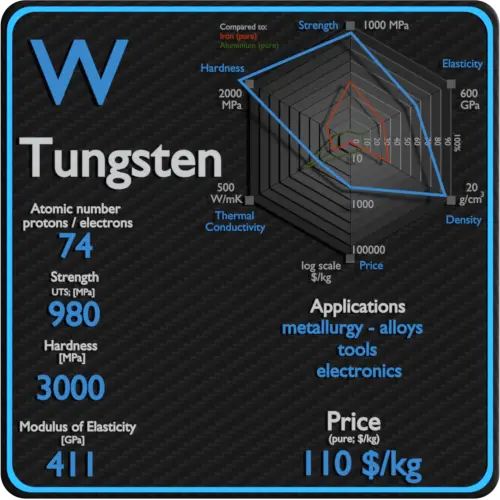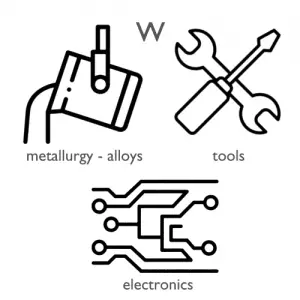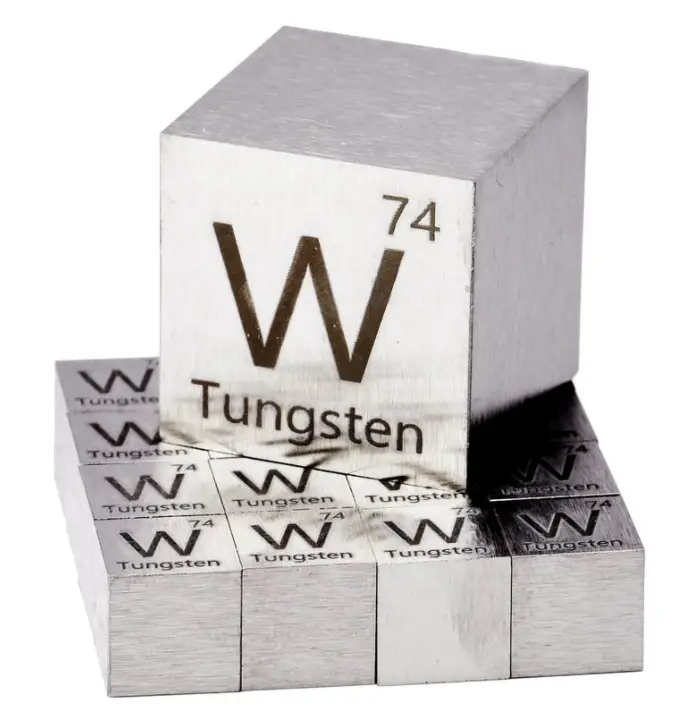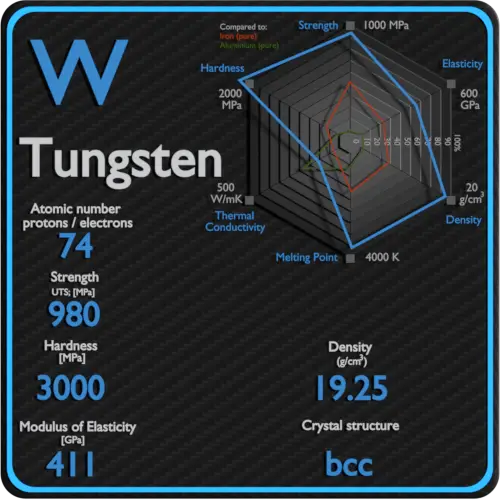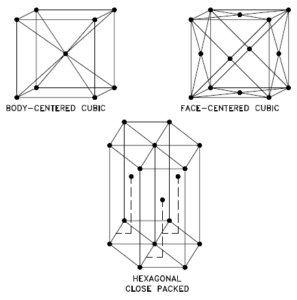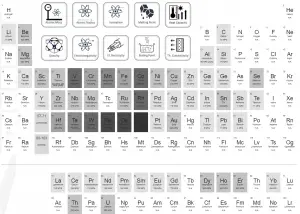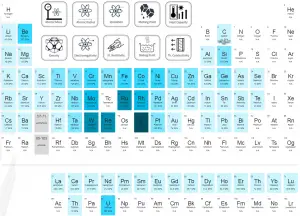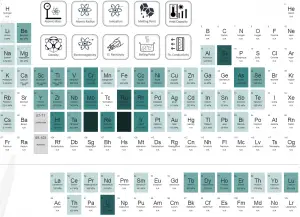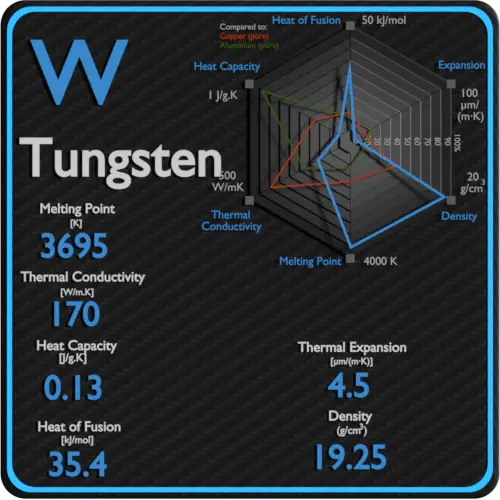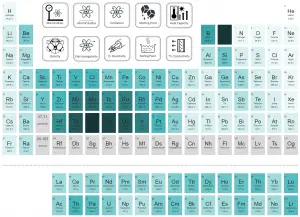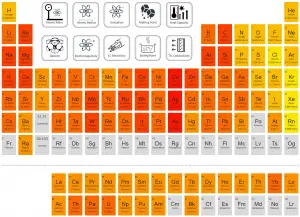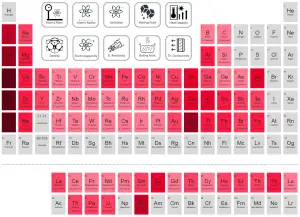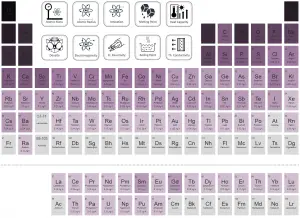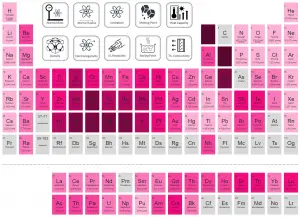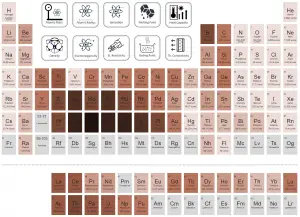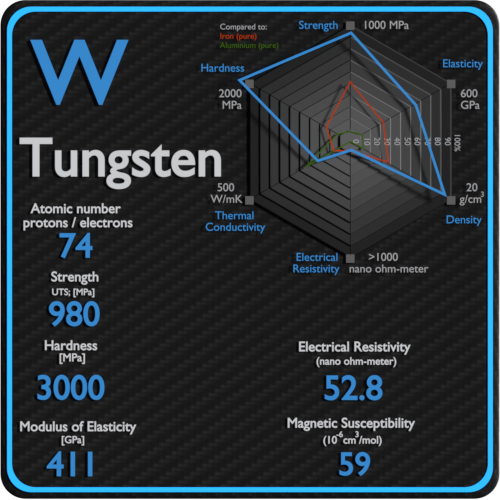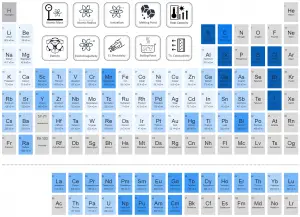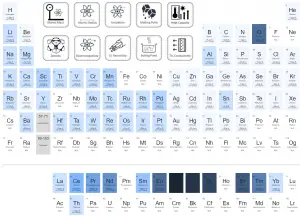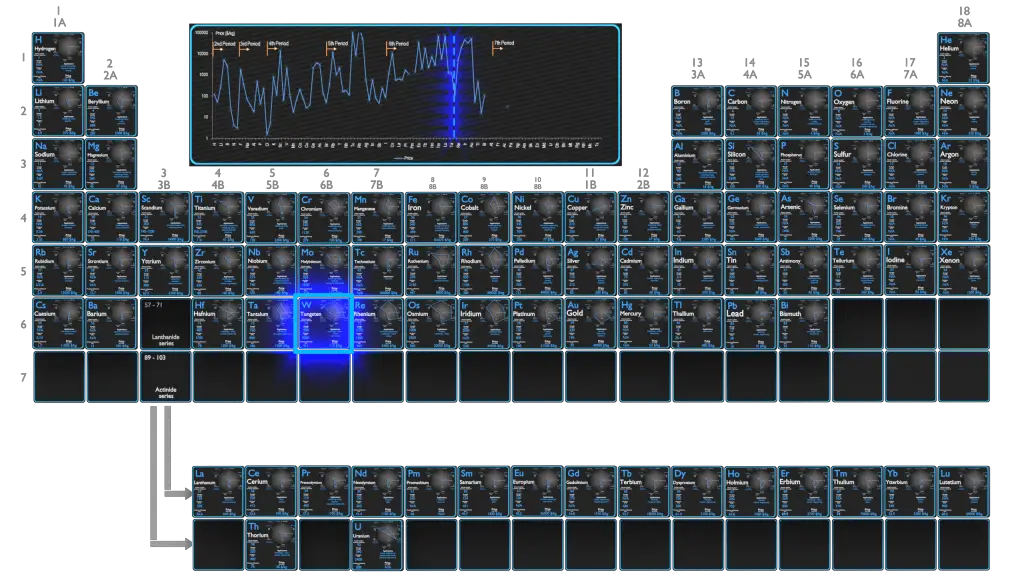About Tungsten
Tungsten is a rare metal found naturally on Earth almost exclusively in chemical compounds. Tungsten is an intrinsically brittle and hard material, making it difficult to work.
Summary
| Element | Tungsten |
| Atomic number | 74 |
| Element category | Transition Metal |
| Phase at STP | Solid |
| Density | 19.25 g/cm3 |
| Ultimate Tensile Strength | 980 MPa |
| Yield Strength | 750 MPa |
| Young’s Modulus of Elasticity | 411 GPa |
| Mohs Scale | 7.5 |
| Brinell Hardness | 3000 MPa |
| Vickers Hardness | 3500 MPa |
| Melting Point | 3410 °C |
| Boiling Point | 59300 °C |
| Thermal Conductivity | 170 W/mK |
| Thermal Expansion Coefficient | 4.5 µm/mK |
| Specific Heat | 0.13 J/g K |
| Heat of Fusion | 35.4 kJ/mol |
| Heat of Vaporization | 824 kJ/mol |
| Electrical resistivity [nanoOhm meter] | 52.8 |
| Magnetic Susceptibility | +59e-6 cm^3/mol |
Applications of Tungsten
Tungsten is widely used metal. Approximately half of the tungsten is consumed for the production of hard materials – namely tungsten carbide – with the remaining major use being in alloys and steels. Mining and mineral processing demand wear-resistant machines and components, because the energies and masses of interacting bodies are significant. For this purposes, materials with the highest wear-resistance must be used. For example, tungsten carbide is used extensively in mining in top hammer rock drill bits, downhole hammers, roller-cutters, long wall plough chisels, long wall shearer picks, raiseboring reamers, and tunnel boring machines. The remaining 40% is generally used to make various alloys and specialty steels, electrodes, filaments, wires, as well as diverse components for electric, electronic, heating, lighting, and welding applications. High-speed steels are complex iron-base alloys of carbon, chromium, vanadium, molybdenum, or tungsten (as much as 18%), or combinations there of.
Production and Price of Tungsten
Raw materials prices change daily. They are primarily driven by supply, demand and energy prices. In 2019, prices of pure Tungsten were at around 110 $/kg.
The two major minerals of tungsten are wolframite and scheelite. Wolframite is strong, very dense, and has a high melting point. The tungsten ores are crushed, cleaned, and treated with alkali, resulting in the production of tungsten trioxide (WO3). The world’s reserves of tungsten are 3,200,000 tonnes; they are mostly located in China (1,800,000 t), Canada (290,000 t),[49] Russia (160,000 t), Vietnam (95,000 t) and Bolivia. As of 2017, China, Vietnam and Russia are the leading suppliers with 79,000, 7,200 and 3,100 tonnes, respectively.
Source: www.luciteria.com
Mechanical Properties of Tungsten
Strength of Tungsten
In mechanics of materials, the strength of a material is its ability to withstand an applied load without failure or plastic deformation. Strength of materials basically considers the relationship between the external loads applied to a material and the resulting deformation or change in material dimensions. In designing structures and machines, it is important to consider these factors, in order that the material selected will have adequate strength to resist applied loads or forces and retain its original shape. Strength of a material is its ability to withstand this applied load without failure or plastic deformation.
For tensile stress, the capacity of a material or structure to withstand loads tending to elongate is known as ultimate tensile strength (UTS). Yield strength or yield stress is the material property defined as the stress at which a material begins to deform plastically whereas yield point is the point where nonlinear (elastic + plastic) deformation begins.
See also: Strength of Materials
Ultimate Tensile Strength of Tungsten
Ultimate tensile strength of Tungsten is 980 MPa.
Yield Strength of Tungsten
Yield strength of Tungsten is 750 MPa.
Modulus of Elasticity of Tungsten
The Young’s modulus of elasticity of Tungsten is 750 MPa.
Hardness of Tungsten
In materials science, hardness is the ability to withstand surface indentation (localized plastic deformation) and scratching. Brinell hardness test is one of indentation hardness tests, that has been developed for hardness testing. In Brinell tests, a hard, spherical indenter is forced under a specific load into the surface of the metal to be tested.
Brinell hardness of Tungsten is approximately 3000 MPa.
The Vickers hardness test method was developed by Robert L. Smith and George E. Sandland at Vickers Ltd as an alternative to the Brinell method to measure the hardness of materials. The Vickers hardness test method can be also used as a microhardness test method, which is mostly used for small parts, thin sections, or case depth work.
Vickers hardness of Tungsten is approximately 3500 MPa.
Scratch hardness is the measure of how resistant a sample is to permanent plastic deformation due to friction from a sharp object. The most common scale for this qualitative test is Mohs scale, which is used in mineralogy. The Mohs scale of mineral hardness is based on the ability of one natural sample of mineral to scratch another mineral visibly.
Tungsten is has a hardness of approximately 7.5.
See also: Hardness of Materials
Tungsten – Crystal Structure
A possible crystal structure of Tungsten is body-centered cubic structure.
In metals, and in many other solids, the atoms are arranged in regular arrays called crystals. A crystal lattice is a repeating pattern of mathematical points that extends throughout space. The forces of chemical bonding causes this repetition. It is this repeated pattern which control properties like strength, ductility, density, conductivity (property of conducting or transmitting heat, electricity, etc.), and shape. There are 14 general types of such patterns known as Bravais lattices.
See also: Crystal Structure of Materials
Crystal Structure of Tungsten
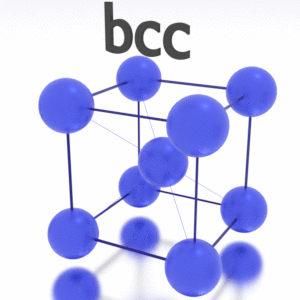
Thermal Properties of Tungsten
Tungsten – Melting Point and Boiling Point
Melting point of Tungsten is 3410°C.
Boiling point of Tungsten is 59300°C.
Note that, these points are associated with the standard atmospheric pressure.
Tungsten – Thermal Conductivity
Thermal conductivity of Tungsten is 170 W/(m·K).
The heat transfer characteristics of a solid material are measured by a property called the thermal conductivity, k (or λ), measured in W/m.K. It is a measure of a substance’s ability to transfer heat through a material by conduction. Note that Fourier’s law applies for all matter, regardless of its state (solid, liquid, or gas), therefore, it is also defined for liquids and gases.
Coefficient of Thermal Expansion of Tungsten
Linear thermal expansion coefficient of Tungsten is 4.5 µm/(m·K)
Thermal expansion is generally the tendency of matter to change its dimensions in response to a change in temperature. It is usually expressed as a fractional change in length or volume per unit temperature change.
Tungsten – Specific Heat, Latent Heat of Fusion, Latent Heat of Vaporization
Specific heat of Tungsten is 0.13 J/g K.
Heat capacity is an extensive property of matter, meaning it is proportional to the size of the system. Heat capacity C has the unit of energy per degree or energy per kelvin. When expressing the same phenomenon as an intensive property, the heat capacity is divided by the amount of substance, mass, or volume, thus the quantity is independent of the size or extent of the sample.
Latent Heat of Fusion of Tungsten is 35.4 kJ/mol.
Latent Heat of Vaporization of Tungsten is 824 kJ/mol.
Latent heat is the amount of heat added to or removed from a substance to produce a change in phase. This energy breaks down the intermolecular attractive forces, and also must provide the energy necessary to expand the gas (the pΔV work). When latent heat is added, no temperature change occurs. The enthalpy of vaporization is a function of the pressure at which that transformation takes place.
Tungsten – Electrical Resistivity – Magnetic Susceptibility
Electrical property refers to the response of a material to an applied electric field. One of the principal characteristics of materials is their ability (or lack of ability) to conduct electrical current. Indeed, materials are classified by this property, that is, they are divided into conductors, semiconductors, and nonconductors.
See also: Electrical Properties
Magnetic property refers to the response of a material to an applied magnetic field. The macroscopic magnetic properties of a material are a consequence of interactions between an external magnetic field and the magnetic dipole moments of the constituent atoms. Different materials react to the application of magnetic field differently.
See also: Magnetic Properties
Electrical Resistivity of Tungsten
Electrical resistivity of Tungsten is 52.8 nΩ⋅m.
Electrical conductivity and its converse, electrical resistivity, is a fundamental property of a material that quantifies how Tungsten conducts the flow of electric current. Electrical conductivity or specific conductance is the reciprocal of electrical resistivity.
Magnetic Susceptibility of Tungsten
Magnetic susceptibility of Tungsten is +59e-6 cm^3/mol.
In electromagnetism, magnetic susceptibility is the measure of the magnetization of a substance. Magnetic susceptibility is a dimensionless proportionality factor that indicates the degree of magnetization of Tungsten in response to an applied magnetic field.
